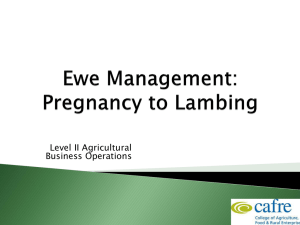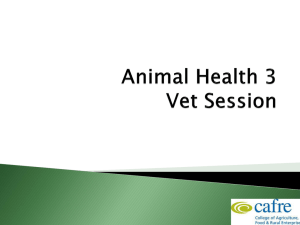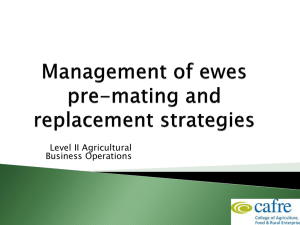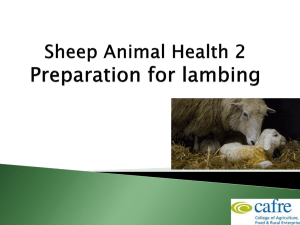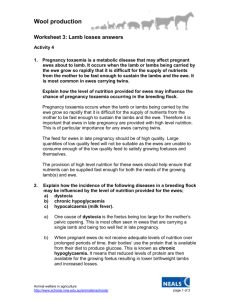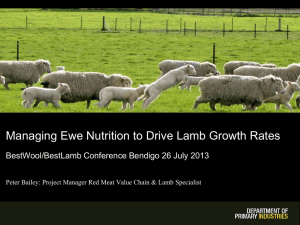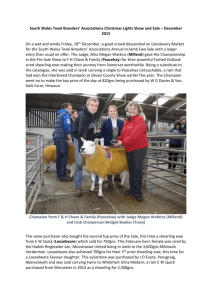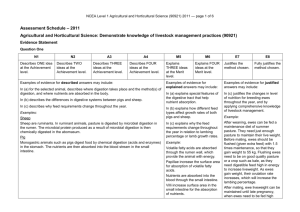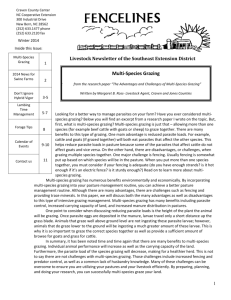Teagasc Sheep/Research Demo Farm
advertisement
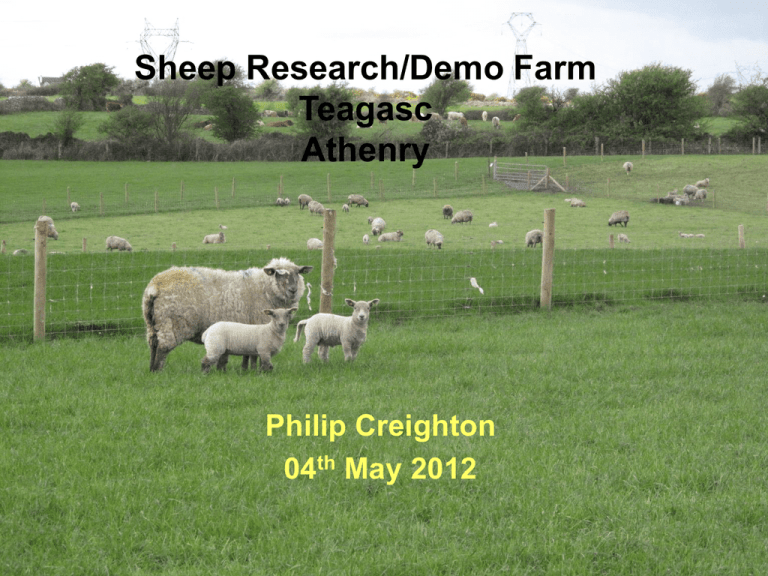
Sheep Research/Demo Farm Teagasc Athenry Philip Creighton 04th May 2012 Research Demo Farm Objective: • To develop profitable and sustainable pasture-based systems of sheep production Key areas: • Stocking rate • Prolificacy • Grass supply and demand • Lamb performance at pasture Sub Objectives Describe treatment effects on: • Feed requirements of systems • Animal performance • Pasture growth, utilisation and quality • Economic impact Research Focus • Optimum Stocking rate (ewes/ha) • Prolificacy (lambs weaned/ewe) • Lamb growth rates pre /post weaning • Finishing lambs from grass • Working towards refining Breeding index Research study Stocking Rate Low Medium High (10 ewes/ha) (12 ewes/ha) (14 ewes/ha) Prolificacy Medium High (1.5 lambs weaned/ewe) (1.8 lambs weaned/ewe) Full system farmlets – self sufficient systems Objective • Investigate the effects of stocking rate and ewe prolificacy on ; • Lamb output/ewe and /ha • Feed requirement and budgets • Pasture growth and utilisation • Overall system profitability Closed system study System study • 6 groups – 60 animals per group = 360 ewes • Medium prolific strain – Dominant breed type on farm – Suffolk X ewe • High prolific strain – Belclare X ewe • Allow for comparison of the effects of stocking rate and lamb output per ewe Farm Layout Management Six independent farmlets • 10 ewes/ha Medium Prolificacy (LM- Blue) High Prolificacy (LH- Purple) • 12 ewes/ha Medium Prolificacy (MM- Black) High Prolificacy (MH- Red) • 14 ewes/haMedium Prolificacy (HM- Yellow) High Prolificacy (HH- Green) Grassland measurements • Full quantification of system • Pre and post DM yields (utilisation) • Daily herbage allowance • Daily intake • Pasture quality (weekly) • Leaf, stem and dead (fortnightly) • Farmlet areas – self sufficient- forage bought in if not possible • Feed budgets Grass Utilisation Grass production • Potential from grass/clover system Intake requirements/feed budget • Ewes and Lambs Grass measurement and budgeting • Adoption • Improving Sward Quality/content • Suitability / Sustainability of Grass/clover varieties Animal performance • Lamb performance at pasture • Growth rate pre and post weaning • Health • Mortality • Parasite challenge • Drafting pattern • Drafting rates • grass budget – lambs finished or sold as stores Update Scanning Litter Size Medium prolificacy High prolificacy Singles 29 19 Twins 135 120 Triplets 13 33 Quadruples 0 3 Barren 3 5 Avg Litter size 1.87 2.06 Raw data – not statistically analysed Lambing 2012 • • • • Lambing commenced March 3rd 80% lambed in first 17days 95% lambed by end of March Mortality • Average ~9% • HP ~11% • MP ~7% Birth date 12/04/2012 10/04/2012 08/04/2012 06/04/2012 04/04/2012 02/04/2012 31/03/2012 29/03/2012 27/03/2012 25/03/2012 23/03/2012 21/03/2012 19/03/2012 17/03/2012 15/03/2012 13/03/2012 11/03/2012 09/03/2012 07/03/2012 05/03/2012 03/03/2012 Lambs born/day Lambing 2012 Lambing Spread 2012 90 80 70 60 50 40 30 20 10 0 Flock Health • Ewe Mortality • 3.5-4% (Jan-Mar 2012) • Clostridia – Sordelli • E- coli Mastitis • Prolapse • Meningitis Grassland • Paddocks closed rotationally from late October • Growth rate of 3-4kg DM/day over winter (mild conditions) • First paddocks grazed cover of 1200-1300kg DM/ha (89cm) • Very strong grass growth during March 30-60 kg DM/ha /day • 25% of farmlet areas removed in late March for silage • Mild winter, Reseeded swards • Further 15% of LSR farmlets removed in early April • May need to graze some of this Grassland • Current situation • Growth rate of ~35-40 Kg DM/ha/day • ~10 days grass ahead @allowance of 3kg DM/head/day • Intake ranging 2.8-3.2kg DM/day • Silage removed to bring ground in • 50-100% of winter feed requirements achieved Grassland • Plot work • Clover persistency • Athenry/Moorepark/DAFM • Grazing with sheep • Herbage mass • Sward clover content • Stolon mass + tiller density • Quality • Dept evaluation trial • Cut and graze

